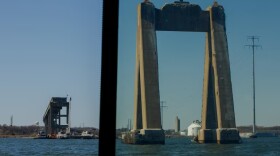Around 1:17 in the morning on March 26, 2024, light music started playing in the bridge of the Dali.
Ten minutes later, the ship will strike the Francis Scott Key Bridge, causing its collapse and creating one of the largest maritime disasters in U.S. history.
Six construction workers on the Key Bridge will be killed from the impact — and through all the chaos, the music played.
The latest release from the National Transportation Safety Board shows recorded communications between the crew of the ship and gives an intimate look at what happened the night the Key Bridge fell.
Allen Black, a professor of maritime law at the University of Maryland, said the transcripts can be revealing about what happened on deck as accidents unfold.
“They're always really interesting to read because they put you in the pilot house at the time of the casualty. So I think it was a very good view of the emergency situation, you know, as it developed, and how it went from a routine early morning departure to a tragedy in a matter of just a few minutes,” Black said.
What happened March 26, 2024
The transcript shows that the crew seemed to be going about their routines as they left the Port of Baltimore with pilots onboard.
Maritime pilots are professionals experienced in navigating specific ports and boards to help them traverse tricky areas.
Around 1:11 in the morning, the Dali’s shipmaster is asking the pilots how they’d like their coffee prepared.
The pilots continue chatting on the ship until multiple alarms go off at once around 1:24 a.m.
One pilot curses, while the other says uh oh.
The ship no longer had electricity.
“The problem comes when they have that loss of power and they're trying to drop the anchor,” said Steven Willis who is with the Center for Maritime Strategy.
Court documents show brake failures on one of the anchors.
“The hydraulic brake on the Dali’s port anchor windlass was inoperable — and had been inoperable for nearly two weeks,” the state lawyers wrote. “That unseaworthy condition meant the port anchor windlass could only be operated with the manual brake, a two-man job. Despite that situation, only one man was posted to the Dali’s bow on March 26, which meant when the time came to deploy the anchor, he was unable to do so.”
The NTSB investigation shows that the Dali had lost power the afternoon before causing similar alarms, the master filed a report, but did not verbally tell the pilots of the issue.
“There are certainly questions around what information was conveyed to the pilots when they got on board. it did not appear that the pilots were made aware of the alarms that had gone off the day before,” said John Wesley Lee, a licensed commercial captain and marine inspector. “That’s unfortunate, because those are the same alarms that, you know, went off notifying the bridge that they had a major mechanical casualty.”
Seconds later the crew and pilots report that they’ve lost steering and the ship is veering to the right, straight toward the Key Bridge.
At this point, Black says the ship is moving at about a thousand feet per minute, a speed hard to stop for a vessel can carry more than a quarter of a billion pounds.
In a last-ditch effort, the crew pilot orders the ship to pull fully to the left, and drop the left anchor.
But, according to court documents, the brake for the device that drops the anchor is broken and can only be operated manually, a two-man job.
At the time only one man was at the station.
At that point it’s too late, a slew of expletives come from the crew and pilots.
At 1:29 a.m. the pilots say to call for the Coast Guard, that the Key Bridge is down.
The light music continues over the radio, the alarms continue to blare.
Maryland is facing blame of its own for impact.
A March National Transportation Safety Board report found Maryland’s transportation authority failed to assess the Francis Scott Key Bridge for threats for decades, leaving the bridge 30 times more vulnerable than thresholds set by industry standards.
“The MDTA would have been able to proactively identify strategies to reduce the risk of a collapse and loss of lives associated with a vessel collision with the bridge,” said NTSB Chair Jennifer Homendy when the report was released. “What's frustrating is, not only did MDTA fail to conduct the vulnerability assessment on the Key Bridge, they did not provide, nor were they able to provide, the NTSB with the data needed to conduct the assessment, including the characteristics of vessel traffic passing under the bridge, vessel transit speeds, vessel loading characteristics.”
The trail Grace Ocean and Synergy is set for next summer.









